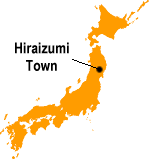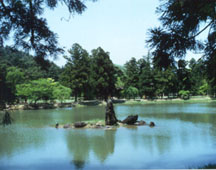

 |
||

|
Masterpiece Retaining 800-year-old Aesthetics
 The ruins of Motsuji Temple in Hiraizumi Town, Iwate Prefecture, are, like Chusonji Temple, a reminder of the prosperity of the three generations of the Fujiwara family in the 12th century under whose reign there flourished a magnificent aristocratic culture. While the Golden Hall built in the 12th century still remains at Chusonji Temple which was the family temple of the three generations of the Fujiwara family, all the buildings of Motsuji Temple were destroyed by repeated fires in later years. But, according to some historians, Motsuji Temple was even more prosperous than Chusonji Temple and had 40 temples and shrines and 500 priest's cells in its precincts. Today only the foundations and base structure of some of those buildings remain alongside of the main hall and other structures reconstructed recently. However, the garden, with its pond and laid-out rocks, preserves its original design. Created in the middle of the 12th century, the garden is said to be the only remaining example of a Jodo Garden (a garden designed based on a diagram of mandala which depicts the pure land where Buddha and bodhisattva live), a typical design of garden in the Heian Period (798-1192). Oizumi Pond in the center of the garden is almost intact as it was 800 years ago. The teardrop-shaped isle in the middle of the pond and the skillfully distributed rocks are in an exquisite balance, and the crystal surface of the pond reflects the surrounding trees. The tranquil sight gives visitors peace of mind. Motsuji Temple is also known as "the temple of flowers." In the precincts, a variety of flowers and trees bloom throughout the year; ume (Japanese apricot) blossom in early spring, cherry blossom in spring, azaleas, irises, Chinese bellflowers, and lotus in summer, subtle hagi (Japanese bush clover) and maple trees changing color in autumn. Among them, the irises are particularly famous: 30,000 irises of 300 species can be seen in full bloom at the end of June and the beginning of July, when the annual Iris Festival attracts many visitors. Photo: Jodo Garden of Motsuji Temple (Iwate Prefecture). Unauthorized reproduction of the
photos in this page is prohibited.
Related Links: |
|

